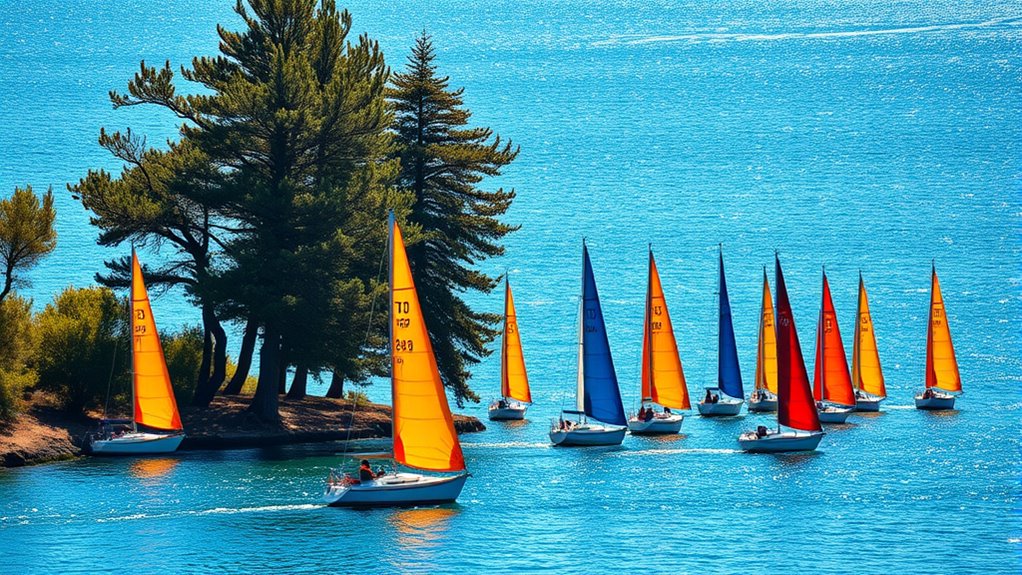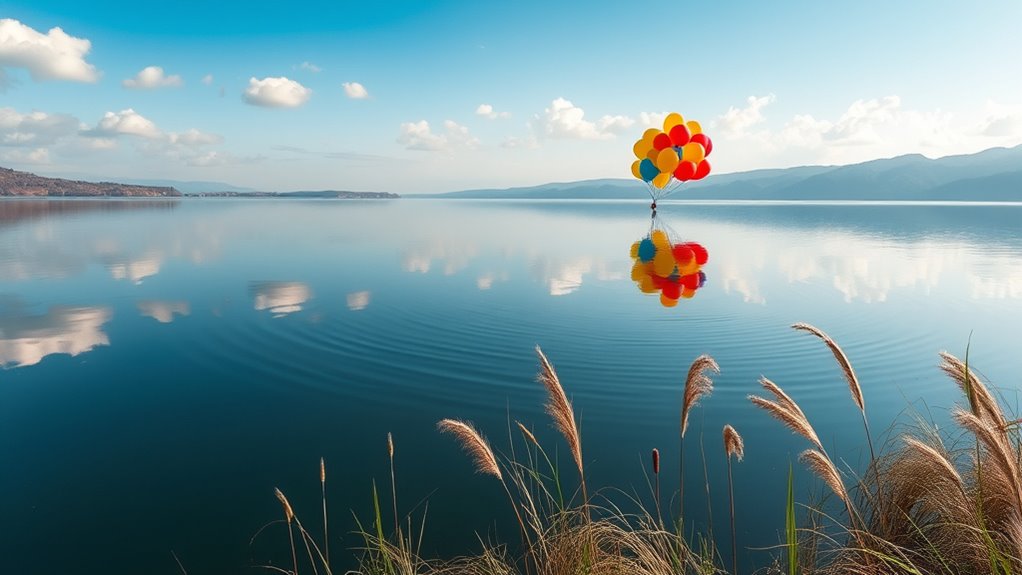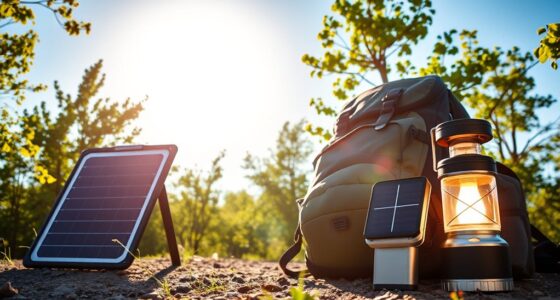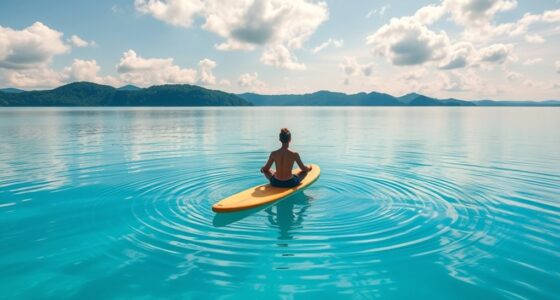Wind applies lateral forces on floating platforms, challenging their stability and balance. Its effect depends on wind speed, direction, and the platform’s shape and design. Strong winds can cause tilting, sway, or even capsizing if not properly managed. To guarantee safety, features like a lower center of gravity and a broad base are essential, along with structural reinforcements. Continue exploring to discover how thoughtful designs help mitigate wind’s impact on floating stability.
Key Takeaways
- Wind pressure exerts lateral forces that challenge the stability of floating platforms, potentially causing tilting or capsizing.
- Platform shape and design influence how wind pressure is distributed, affecting overall stability.
- Structural features like a low center of gravity and broad base help counteract wind-induced instability.
- Wind effects can be amplified when combined with waves and currents, increasing the risk of platform destabilization.
- Proper design, reinforcement, and modeling are essential to ensure floating stability under varying wind conditions.

When wind blows across a floating platform, it can considerably impact its stability. The force exerted by the wind, known as wind pressure, pushes against the vessel’s surfaces, creating lateral forces that challenge its balance. This pressure isn’t uniform; it varies with wind speed, direction, and the shape of the platform. As you consider vessel design, understanding how wind pressure interacts with structural features becomes essential. A well-designed vessel accounts for these forces, distributing them efficiently to prevent excessive tilting or even capsizing. The shape of the platform, including its height, width, and overall geometry, influences how wind pressure distributes across its surface. Streamlined or aerodynamically optimized designs tend to experience less adverse effect, as they reduce the wind’s impact by minimizing turbulent airflow and pressure differentials. Additionally, selecting appropriate materials can increase the resilience of the platform against these forces.
In the context of vessel design, engineers incorporate features that help mitigate the effects of wind pressure. For example, lowering the center of gravity can aid in maintaining stability, while broadening the platform’s base increases its resistance to lateral forces. Additionally, using sturdy materials and reinforced structural elements ensures that the vessel can withstand fluctuating wind pressures over time. When designing floating platforms, you must consider not only the maximum expected wind speeds but also how those winds will influence the vessel’s response. The goal is to create a structure that remains stable under various conditions, preventing excessive sway or tilting that could compromise safety or operational efficiency.
You should also pay attention to how wind pressure interacts with other environmental forces, such as waves and currents. These combined forces can amplify the destabilizing effect on your platform, making the importance of proper vessel design even more evident. Incorporating advanced computational modeling during the design phase allows you to simulate these conditions and optimize the vessel’s shape and structural features accordingly. This proactive approach helps ensure that wind pressure doesn’t become a critical threat to stability during actual operations. Moreover, understanding the effects of environmental forces can guide future improvements in vessel resilience and safety.
Ultimately, understanding how wind pressure affects floating stability is indispensable for safe and efficient vessel design. By considering the interaction between wind forces and structural features, you can develop platforms that withstand gusts and steady winds alike. Proper design choices—such as lowering the center of gravity, optimizing shape, and reinforcing critical areas—serve as your best defenses against wind-related instability. When wind blows across your floating platform, your well-thought-out design ensures it remains steady, secure, and operational despite the challenges posed by nature.
Frequently Asked Questions
How Does Wind Speed Influence Buoyancy Adjustments?
When wind gusts increase, your buoyancy adjustments become more critical to maintain stability. Strong gusts can create additional surface tension on the water, causing fluctuations in your floating position. You might need to shift weight or change your angle to counteract these forces. As wind speed rises, staying alert and making quick buoyancy adjustments helps you stay balanced and secure in fluctuating conditions.
Can Wind Direction Change Floating Stability Over Time?
You bet wind direction can change floating stability over time. When wind gusts shift, they alter atmospheric pressure and create uneven forces on the floating object. This can cause it to tilt or drift, making stability a moving target. As the wind’s course varies, so does the balance, reminding you that stability isn’t set in stone but constantly in flux. Always stay alert to shifting wind patterns to maintain control.
What Materials Best Resist Wind-Induced Instability?
You should choose materials with high durability and a rough surface texture to resist wind-induced instability. Durable materials like treated wood, composites, or specialized plastics withstand constant wind stress, maintaining stability. A textured surface helps break up wind flow, reducing turbulence and uplift. By selecting these materials, you guarantee your floating structure remains steady despite changing wind conditions, enhancing safety and longevity in outdoor environments.
How Do Small Boats Differ From Large Ships in Wind Impact?
Ever wondered why small boats feel more tossed by the wind than large ships? You’ll notice that small boats, like sailboats, rely heavily on cargo stability and design features to counteract wind effects. Unlike large ships, which have greater weight and broader hulls, small boats are more vulnerable to wind because their lighter structure and sailboat design make them less stable. That’s why wind impacts them more noticeably.
Are There Predictive Models for Wind Effects on Floating Objects?
Yes, there are predictive models for wind effects on floating objects. These models consider wind turbulence and gust variability to forecast how wind influences stability and movement. By analyzing factors like wind speed, direction, and turbulence patterns, you can better anticipate shifts caused by gust variability. These models help you understand potential risks and improve safety measures, especially in dynamic conditions where wind turbulence markedly impacts floating stability.
Conclusion
As you stand on a floating platform, the wind’s gentle whisper can lull you into calmness or toss you into chaos. While it may seem invisible and harmless, wind’s power directly challenges your vessel’s stability. Just like a calm day can hide a storm, smooth waters can hide the wind’s strength. Remember, in the dance of wind and water, your stability depends on understanding and respecting this unseen force.










